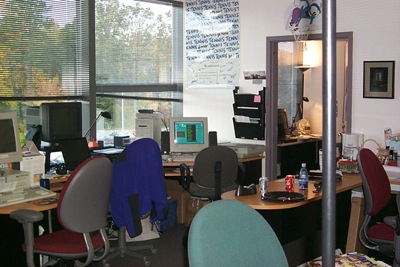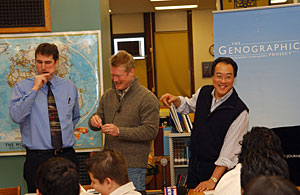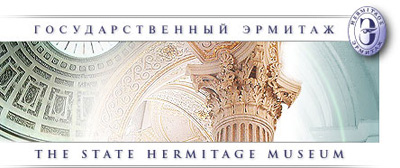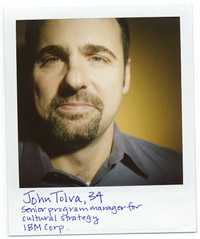IBM@10
Today I mark one decade in the full-time employ of IBM. No, I don’t believe it either.
Back in 1998, as the go-go days of the first boom were about to go-go away, I was struggling between two job offers. IBM’s was low, a producer role at the relatively iconoclast Interactive Media group in Atlanta. The other, with a start-up consultancy called iXL, was much sexier, promising a higher salary and 10,000 options (oh, the promises).
To this day I don’t really know why I chose IBM. Might have been the I in the acronym — the suggestion of a career spent globetrotting and doing business in different cultures. Which is precisely what it turned out to be, though I’ve taken the jetsetting to some kind of perverse extreme. Being in Africa while marking this “anniversary” rather puts an exclamation point on it.

My first office space, IBM Interactive Media, Atlanta
10 years is a completely arbitrary duration of time, but it does feel important somehow. More important than the extra week of vacation, that is. (Seriously, does anyone count vacation days anymore?)
I’d known since the beginning of the year that I wanted to use the anniversary as an evaluation point. And then the Corporate Service Corps opportunity came up I thought, what a perfect way to evaluate my career than to be yanked out of it for a month and plopped into a wholly unfamiliar environment.
With two weeks to go in Africa, I have no stunning insights to share as yet. I suppose if any do come it will be when I am back in the US and can reflect a bit. I do know what I miss and what I don’t (a future post, of course), but as for what I want to be when I grow up … still thinking firefighter, librarian, or World Dictator. Will let you know how it all turns out. (By the way, for those interested in what it is I actually do you can learn more here.)
So how did I celebrate this occasion? I waited until shortly after midnight last night, silently marked the anniversary, went over to the pool, and jumped in fully dressed. Seemed appropriate somehow.
But enough about you
Once upon a time when I was going to be an English professor I studied at Washington University is St. Louis. I bailed out with an MA only and set down a path that took me not as far away from there as I might have thought.
Recently Wash U.’s alumni mag did a feature on me. It’s fluffy, but I’m certain generous alumni benefactors are now crawling out of the woodwork to donate to the school.
That’s where I work, by the way. On the bridge of a starship.
There’s great work being done at Wash U. in the digital humanities these days. If that’s your thing I’d recommend keeping an eye on The Spenser Archive.
Soar with turkeys
Flickr’s Paul Hammond made a comment in his panel at SXSW that’s resonating a bit with a colleague or two.
Process is an antidote to working with stupid people.
It is an understandly resonant phrase at a conference like SXSW where the predominant vibe is entrepreneurial and innovative and all about small-scale Getting Real-inspired business models.
Truth is, I couldn’t agree more. When not everyone is at the same skill or knowledge level (i.e., when they are “idiots” compared to you) a common methodology enables collaboration where sheer similarity of perspective can’t.
But the statement has stuck with me and I think now that it might not be as simple as that. I do, of course, work in a gigantic, process-laden company where there are many arguments for following a common process. Quality assurance is one, presenting a unified approach and brand to customers is another. But both of those could legitimately be accomplished with a small team of non-idiots.
The real value of process comes from the inherent inability of small, smart teams to scale. When your team is based solely on shared perspective (whether of educational background, skill set, or job experience) there are only so many people you can add before that perspective will fray. I don’t know what the limit is, but I imagine it can’t be more than maybe 20 people. At this size some sort of common process needs to be implemented if for no other reason than to allow everyone to speak the same language.
Now, many small companies, especially in tech, recognize this and find it to be no limitation at all. They don’t want to scale beyond their current size. And that’s just fine. Note that I’m not referring to the scale of a project that can be undertaken or the scale of customers that can be served. Small teams can do this as effectively as large companies in many instances.
But if you do want to make your company larger — or if you actively seek diversity of perspective — then having some common framework for working is really the only way to do it. For instance when working on international projects, I find that process, in some cases rigid process, is the only way to work together. In the absence of cultural or language understanding it is sometimes the only common platform from which to work.
Too much process, the wrong process, sometimes any process at all can kill creativity. I see it all the time. And, in truth, I’m lucky to have worked with some of the smartest people in my field for the last seven years. I rarely encounter the need for process. But I do recognize the need and can see where it might usefully be applied with nary an idiot in sight.
Project wisdom from the old NASA
“If a major project is truly innovative, you cannot possibly know its exact cost and its exact schedule at the beginning. And if in fact you do know the exact cost and the exact schedule, chances are that the technology is obsolete.”
— Joseph G. Gavin, Jr., discussing the design of the lunar module* that landed NASA astronauts on the moon.
Yeah, boss. That’s why we’re late and over budget. You don’t want to be obsolete, do you?
[*] The upper half of which is called, ahem, an ascent stage. We’re all about inspirations to innovation around here.
Via SvN.
Gathering in the town square

The MIT Technology Review has a short article on one of my main projects, called Meadan, which I’ve not discussed at all on this blog. Mostly this is because we’re still in development, but recently we embarked on a closed alpha test phase so this seems like as good a time as any.
From the article:
The basic idea is simple: it’s a website that brings English and Arabic speakers together around daily postings of news articles, broadcasts, and events that are of common interest, and it gives users a platform to communicate through dialogues, blogs, and other exchanges. All the while, it allows users to pinpoint their location so that people can share views across continents. The hard part is creating a system that allows users to express their ideas in their native tongue.
What’s really interesting about Meadan — apart from its small part in removing barriers to rationale discourse between the West and the Muslim world — is how it uses social networking technologies both to create communities (the “traditional” use of social networking) but also to enlist users to rate, edit, and correct the English-Arabic machine translation. Social networking as language feedback loop. What’s missing from so much machine translation is a sizable corpus of informal conversation (not bizspeak or medical parlance, for instance). This is what helps MT learn grammatical and dialectical nuance and this is precisely the kind of conversation we envision on the Meadan site.
Much more on this in the coming months, of course.
Stirring the gene pool with a cello bow
There are days where my job is not much fun. Tuesday last week was not one of those days.
I spent the morning with Yo-Yo Ma and his Silk Road Ensemble paired with Dr. Spencer Wells of the Genographic Project. Actually, so did the student body of the Prosser Career Academy, a Chicago public high school on the west side. And this was all part of the Sister Cities Schools program.
Confused? It was a bit of a you-put-your-chocolate-in-my-peanut-butter event, but it actually worked. Sister Cities is a program that encourages multicultural exchange between the planet’s urban centers. Their new schools program extends this by putting students in contact from around the world. The Silk Road Project is a really interesting endeavor by Yo-Yo Ma to demonstrate the interplay of cultures via music, taking the ancient trans-Eurasia trade route as a metaphor for this journey. The Genographic Project in some ways has the same goals — a greater understanding of human diversity — but comes at it by seeking to more fully understand the patterns of human migration out of Africa by mapping genetic markers from people around the world. IBM’s life science group is providing the computational firepower for the massive amount of data that Wells and his team are collecting from the field.

Yo-Yo Ma is a huge fan of the Genographic project. In fact, I think he has a man-crush on Spencer Wells. Together they spoke to an AP History class and explained the goals of each project. The students were given genography kits to plot their own lineage on the world map and Ma played a short piece for the class, explaining the multiple cultural influences that coalesce in classical music. His specific example was how an African dance was incorporated in a piece he played by J.S. Bach.
The full Silk Road Ensemble then entertained an all-school assembly in between video clips of Spencer Wells traveling to crazy remote places to obtain information and blood samples from indigenes. At times the yoking-together of genetics and music seemed a bit forced, but it clearly can be done and does make some sense conceptually. Genetic proliferation and lingustic variation, for example, are tightly coupled; one offers insight where the other falls short. Will be interesting to see if Ma and Wells can uncover other points of intersection between the projects.
The students loved it all, actually. A teacher remarked that she’s never heard a full school assembly so oddly silent. I suppose everyone wonders where they come from, ultimately. One of life’s meta-questions.
See also: Macro-genealogy and A long walk out of Africa
Return to the Hermitage
My first major project when I joined IBM in 1998 pretty much changed my life. I was asked to lead the interface design of a new website for the State Hermitage Museum in St. Petersburg, Russia. The site was to be the public face for some three thousand newly-digitized high resolution scans of artwork. By most measures the site was a resounding success. At the time, and even for a few years afterwards, the site boasted the largest number of high-quality images on any museum website.

But web sites age quickly. Especially sites whose aesthetic impact is as important as its functionality. The site badly needs a facelift. So, in two weeks I’m headed back to St. Petersburg for the first time since 2000. It won’t be the massive overhaul that I undertook before, but I’m certain we’ll come up with something.
It’s strange thinking about returning to a place or project that was so formative to one’s career. You can obviously never go back. It is seven years on and I have an uneasy sense that I’ll be disrupting memories that have crystallized (probably falsely) into my own version of a Golden Age or a myth about the true beginning of my career. This all sounds flighty, I know, but there’s a part of me that wants to keep St. Petersburg associated with wide-eyed naivete and awe. Like not wanting to return to a special place from youth for fear of wrecking the memory of it by seeing it through adult eyes.
I dug up a long e-mail I wrote on one of my first trips to Russia. Here’s a taste (so to say) of the experience.
Call it snobby Americanism if you will, but I demand a positive ID on all soupy meat by-products prior to letting them circular-saw through my digestive system. I’ll drink most anything alcoholic, but, come on, don’t tell me that you opened the bottle of wine before you got to the table to save me the trouble — I can taste that it has been oxidizing in a warm room for about three months now. (Hell, I’ve made hooch that tastes like that.) Even the attempts at more traditional American junk food, which is fairly difficult to screw up, are mostly failures. For example, a waitress asked me if I wanted french fries with a meal the other night so I said sure. I was brought a platter of fries — as an appetizer, mind you — that were so disgustingly salty that my tongue began to wince before each fry reached my tastebuds. It was like magnetic repulsion or something. The fries looked like they had been dragged behind a car across the flats of Nevada. Then, in case I had not had my fill of this delicacy, my main meal arrived with a side order of fries. Thank god I had the refreshing bottle of flaccid wine to wash it all down.
Not exactly culturally sensitive*, to be sure, but also not a memory I want at all sullied by finer dining experiences this time around. I’ll gladly take the hyper-salted fries and a bottle of skunked wine.
[*] A few years after we launched the site, a paper appeared that claimed IBM’s work on the Hermitage site was a form of “cybercolonialism.” Say what you will about that, but the primary argument rested on IBM purportedly forcing the Hermitage to use American English rather than their standard British English. Whenever I read that I chuckle. You will too if can read and know the difference between ‘color’ and ‘colour‘.
Twelve islands
It isn’t exactly news that IBM is interested in virtual worlds, but Friday represented a bit of a milestone when we unveiled our official land in Second Life — twelve interlinked islands, open and built-out for business use, research, internal collaboration, and anything else we can think of. As always, Eightbar has the inside scoop.

It’s exciting times, but not because we’re in Second Life. We’ve been working in SL for months, albeit without the sanctioned presence that this island megaplex gives us. This is important because it represents the results of collaboration between a somewhat bewildering variety of interests inside IBM and it points to much more to come. This event, the founding and development of the twelve islands and not Sam Palmisano’s announcement in Beijing (much as I loved it), is the real beginning of IBM establishing itself in this space (literally).
But what really interests me — end press release, start me release — is that this will be a springboard to the rest of the metaverse. Second Life itself is but an island, really, a popular walled garden that was one of the first to the game. Zoom out and move forward a few years and SL will be just a powers-of-ten-sized chunk of a much larger universe of virtual worlds. The Forbidden City: Beyond Space and Time will be one, as will thousands of others. In fact, to really make an impact there shouldn’t be distinctions between the various worlds. One should be able to hop about as from webpage to webpage, seamlessly. That’s a bit of a dream these days with the leaders in the industry less interested in standards and interop than community-building. But we’ve seen that before with the browser hell of the early web days and we’ll no doubt see it again.
If you’re in Second Life and would like to visit, just search for IBM on the map and pick an island. There’s a lot to see. I’m Immerito Foley in-world. Ping me if you need a guide.
40<40
So here’s the deal on that post about the L train photo shoot. In what can only be described as a momentary lapse of reason, the good people at Crain’s Chicago Business have selected me for their annual 40 Under 40 issue. Sorry if reading that just made coffee shoot out your nose. It’s true. They think I’m important.
The theme of the issue was “sanctuary.” The reporters wanted to know where we went to get away from it all. Well, they picked a bad few months to ask me. With the birth of my daughter (and two rambunctious boys) this summer was completely up-ended. Hmmm, sanctuary, sanctuary? Does locking myself in the bathroom count? Home is crazy; work is crazy; so that left only the commute in between. And thus was born the idea that riding the train is my escape.* This is true to some degree. I can relax, read, or just people-watch. I should probably thank my profile’s author, Mark Scheffler, for not making me out as some sort of trainspotting lunatic.
The issue is full of lots of interesting stats. Would you believe none of the 40 Under 40 (which actually total 43, huh?) has a tattoo and that the honorees are overwhelmingly Cubs fans? The best part is that I get to see fellow honoree Jason Fried (of 37Signals) tomorrow night and (re)introduce myself as a “merchant of complexity.” What a perfect intro line.
So the full profile is online as well as a little slideshow of honorees. The print version is out today.
[*] Ironically the editor chose the easiest photo (me just sitting on the train) for the issue. I can only guess that the several dozen gigabytes of shots of me on the train platform seemed too much like an escape of a different sort. Don’t jump, man!
Corporate lingo watch
Ever since I first heard someone ask to “take this conversation offline” I’ve had a biochemical aversion to corporate parlance, especially when technical terms are used unironically to describe non-technical things. Today’s morsel went something like this:
“Thanks, Bob, I really like those ideas. One that I’d particularly like to double-click on was …”
Shouldn’t it be “click”? I mean, isn’t the implication here that this is an idea that should be followed, like one follows a link? Or is he double-clicking it to run it like an application? Start it up?
You know, if you’re going to lace discussions with technical metaphors that are already a minefield of business-specific terms you could at least strive not to sound like you’ve just discovered the mouse and GUI. Oooh, the pretty icons make my copy of WordPerfect come alive!
Two bitter posts in a row. Feels good.















